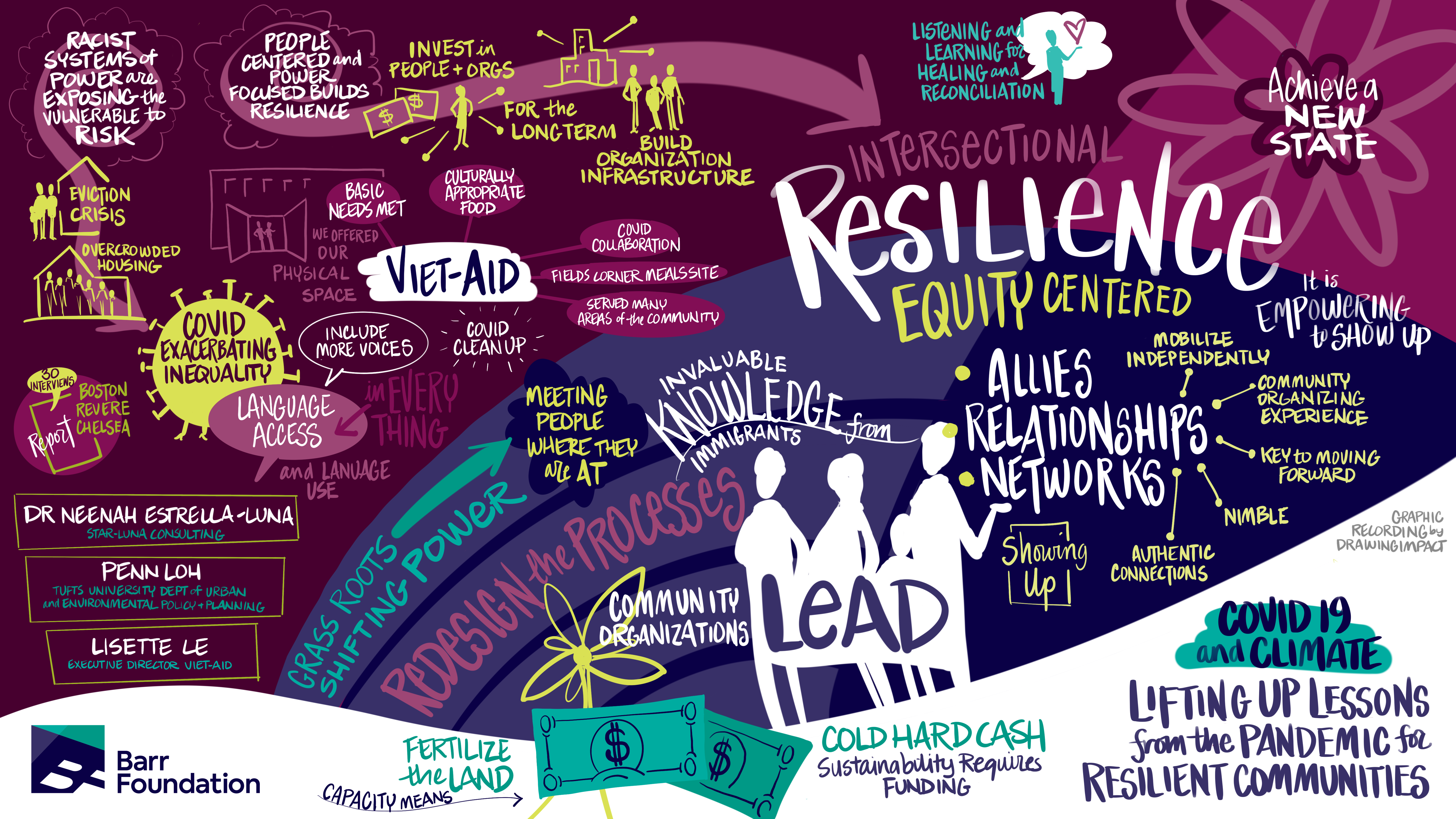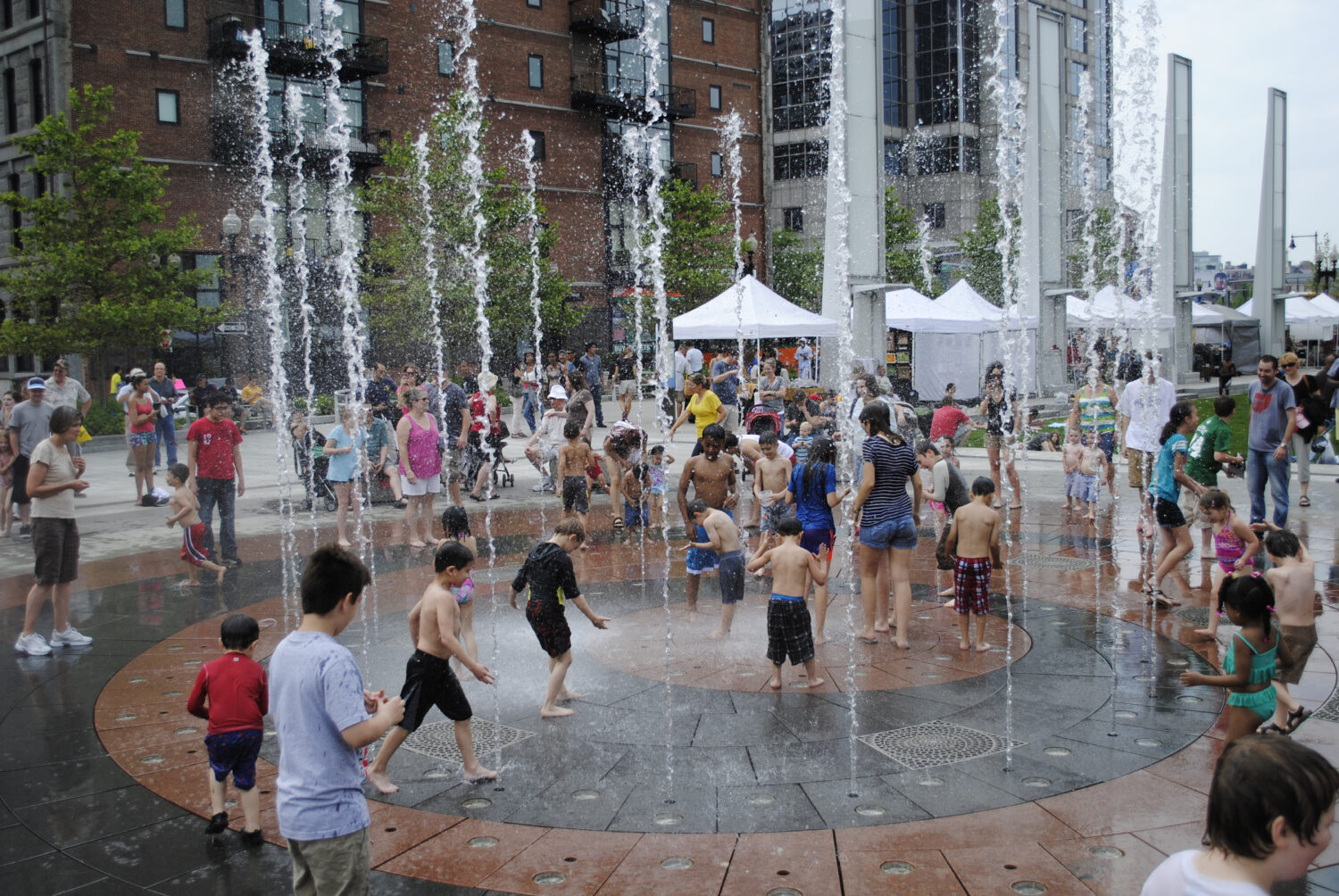Pictured above: Artist Angelique McAlpine’s graphic illustration of a climate resilience webinar hosted by Kalila Barnett, Dr. Neenah Estrella-Luna, Penn Loh, and Lisette Le. See the full graphic here.
Last February, GreenRoots, a Chelsea environmental justice group, was organizing residents to challenge a proposed electrical substation along the Chelsea Creek. By mid-March, those weeks of thoughtful planning and organizing became uncertain as the pandemic shut down almost all activity in Massachusetts. On March 11, GreenRoots convened a call with approximately 15 stakeholders to begin coordinating emergency response amongst community, nonprofit, and governmental partners. That call was the first of 65 consecutive daily calls among a network that grew to 75 people across 10 working groups. This pandemic response in Chelsea, and other working class communities of color, was not just heroic, but an example of resilience in action.
Many other groups found themselves in a similar situation to GreenRoots, pivoting rapidly to provide aid and services. VietAID, a community development corporation serving the Vietnamese-American community in Dorchester, began hosting a weekly food distribution hub serving hundreds every week. The Black Economic Justice Institute distributed $20,000 in gift cards and laundry cards and, as part of the Black Boston COVID-19 Coalition, brought 1,200 people out to the first weekend of mass COVID testing in Roxbury. Mutual Aid Eastie brought together volunteers and East Boston organizations, including Center for Cooperative Development and Solidarity, Neighbors United for a Better East Boston, and Eastie Farm, to deliver 5,000 meals each week in May and June. Matahari Women’s Worker Center trained 20 multilingual volunteers to assist individuals with applying for assistance and helped create the Mass UndocuFund by late March to provide aid for undocumented workers who were not eligible for COVID relief.
When it came to responding to COVID-19, the gap between government response and the needs of historically excluded communities was bridged by nonprofits and networks like the advocates in Chelsea. We wanted to better understand how nonprofits and networks bridged this gap and supported their communities in the early months of the pandemic. Their actions provided a window into what is required to build resilience for climate impacts which we describe in our recent report Opportunities to Invest in Community Resilience for COVID and Climate.
In the process of creating this report, we learned three key lessons from the 30 individuals, representing 18 organizations in Boston, Chelsea, and Revere, who shared their pandemic response stories with us.
1. Racism is at the root of vulnerability
Racism and other systems of oppression are the primary drivers behind the inequities we saw and continue to see. The communities most vulnerable to, and most burdened by economic, housing, and educational injustices are where we found the highest COVID infection and death rates. They were also the communities denied early access to vaccines despite being at the highest risk of exposure. What COVID made clear to the community-based organizations we spoke with is that resilience in the face of a pandemic, climate change, or any other impact is not possible without dismantling racism and other systems of oppression. It was these systems and their impacts that created the devastating inequities seen throughout the pandemic. These disparities will be replicated in climate emergencies until there is a firm and focused commitment to racial justice.

A graphic illustration from the report exploring how racism is at the root of vulnerability. See full illustration here.
2. Resilience requires investing in equity-centered organizations
We should not limit building climate resilience to clean energy infrastructure, building adaptation, or to climate mitigation measures. Resilience is fundamentally a social concept about how people respond and adapt to shocks. Therefore, building resilience means investing in the organizations and efforts focused on strengthening community and the capacity to work with and care for one another. Resilience should not be about bouncing back to a status quo of structural racism and inequalities; it requires centering equity by challenging systemic injustice and advocating for change. In order to build society-wide resilience, funder priorities need to shift from investing in programs and products to long-term, unrestricted, and sustained investments in the capacity and infrastructure of grassroots, community-based organizations building movements for social change. It will also require trust-based grantmaking approaches, or perhaps extending the same trust to equity-centered organizations that is typically provided to mainstream or White-led nonprofit organizations.

A graphic illustration from the report exploring key ideas for building investment, trust, and networks. See full illustration here.
3. Supporting network building is a key resilience strategy
The strongest and most sustained COVID response efforts were those coordinated by individuals and organizations who were part of pre-existing networks. Creating or supporting the structures for relationship and trust building between community-based, grassroots, and social movement organizations lays the foundation for sustainable resilience. These efforts should be funded in addition to, and not at the expense of, core support to frontline organizations. We recommend learning exchanges for foundations to learn from equity-centered, community-based organizations about how to invest in a people-centered, intersectional, anti-racist approach to building resilience.
Community-based responses to COVID are building resilience that can also respond to climate and other impacts. It’s important to note that grassroots organizations should never be relied upon as a substitute for adequate and equitable governmental response. Indeed, these organizations exist because of the long history and unresolved legacy of exclusion, neglect, and social marginalization.
Foundations can and should play a role in changing the systems that create vulnerability in the first place. They can do this by engaging in long-term, trust-based investment in community building aimed at dismantling racism and other systems of oppression.
Additional resources
We recently hosted a webinar to lift up findings from our report and engage Barr’s partners in discussion about the pandemic response and climate resilience. Watch the webinar recording:





